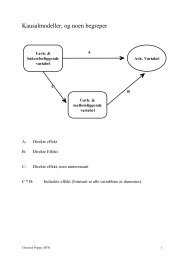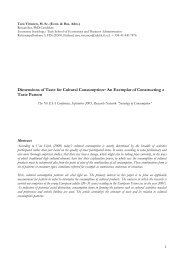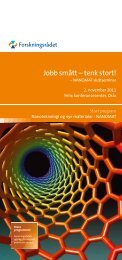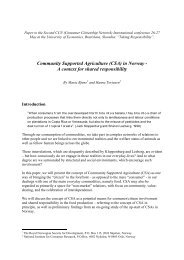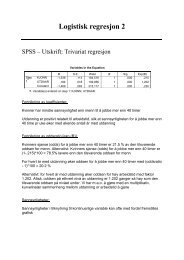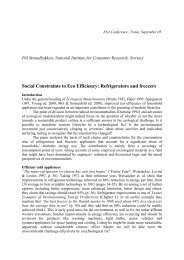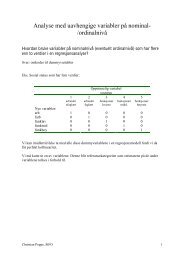an investigation of domestic laundry in europe - habits ... - SIFO
an investigation of domestic laundry in europe - habits ... - SIFO
an investigation of domestic laundry in europe - habits ... - SIFO
You also want an ePaper? Increase the reach of your titles
YUMPU automatically turns print PDFs into web optimized ePapers that Google loves.
Summary 13possibility is that the dosage on the label is too low. We may conclude thatNorwegi<strong>an</strong>s consume much more energy th<strong>an</strong> the Sp<strong>an</strong>ish to ga<strong>in</strong> the samewash perform<strong>an</strong>ce for their white textiles.All the liquid detergents we tested have a signific<strong>an</strong>tly lower wash perform<strong>an</strong>ceth<strong>an</strong> the compact detergents tested. In fact, the wash perform<strong>an</strong>ce whenus<strong>in</strong>g water alone is similar to us<strong>in</strong>g the Sp<strong>an</strong>ish liquid detergent. The dosageused for the Sp<strong>an</strong>ish detergent is quite high, <strong>an</strong>d this may have caused thevery bad results for this particular detergent. The poor results, comb<strong>in</strong>ed withthe extremely high foam level dur<strong>in</strong>g test<strong>in</strong>g, may <strong>in</strong>dicate that a differentprogramme with less mech<strong>an</strong>ical action <strong>an</strong>d less programme duration is morelikely to be used for this detergent <strong>in</strong> Spa<strong>in</strong>. The liquid detergents from theother countries are signific<strong>an</strong>tly better th<strong>an</strong> us<strong>in</strong>g just water, but <strong>in</strong> terms <strong>of</strong>wash perform<strong>an</strong>ce alone we would advise consumers to use other types <strong>of</strong>detergents. However, with regard to r<strong>in</strong>se perform<strong>an</strong>ce, we f<strong>in</strong>d that the liquiddetergents have high r<strong>in</strong>se efficiency compared to the other types <strong>of</strong> detergents.This is valuable <strong>in</strong>formation for people with allergic reactions fromresidual detergent after wash.Temperature effects <strong>of</strong> the wash<strong>in</strong>g processThe <strong><strong>in</strong>vestigation</strong>s <strong>in</strong> this study <strong>in</strong>dicate that the results from the wash<strong>in</strong>g perform<strong>an</strong>cetest at different temperatures do not seem to be as differentiated(specially between Norway <strong>an</strong>d Greece) as was found <strong>in</strong> a previous <strong><strong>in</strong>vestigation</strong>done by the A.I.S.E [16].From the research results <strong>of</strong> the hygienic study, there are strong <strong>in</strong>dicationsthat the hygiene quality <strong>of</strong> washed <strong>laundry</strong> when still wet is related to thewash<strong>in</strong>g temperature <strong>an</strong>d the presence <strong>of</strong> bleach<strong>in</strong>g agents. A general observationis that the result <strong>of</strong> wash<strong>in</strong>g processes at low temperatures (15 <strong>an</strong>d 30°C)shows a rather low hygienic quality. Hardly <strong>an</strong>y reduction <strong>in</strong> numbers <strong>of</strong> micro-org<strong>an</strong>ismsis achieved. This is confirmed by <strong>an</strong> additional test. Almost allmicro-org<strong>an</strong>isms were removed from the <strong>laundry</strong> samples by a 95°C programmeus<strong>in</strong>g a detergent conta<strong>in</strong><strong>in</strong>g bleach.One <strong>of</strong> the most <strong>in</strong>terest<strong>in</strong>g f<strong>in</strong>d<strong>in</strong>gs is that wash<strong>in</strong>g at low temperaturesseems to spread micro-org<strong>an</strong>isms among the different <strong>laundry</strong> items <strong>in</strong> awash<strong>in</strong>g sample rather th<strong>an</strong> remov<strong>in</strong>g them. Temperature <strong>an</strong>d hardness <strong>of</strong> waterboth affect wash<strong>in</strong>g efficiency. Temperature alone is far more decisiveth<strong>an</strong> hardness alone. Together there might be a re<strong>in</strong>forcement <strong>of</strong> effects, butthis must be <strong>an</strong>alyzed further <strong>in</strong> order to reach a conclusive result.




